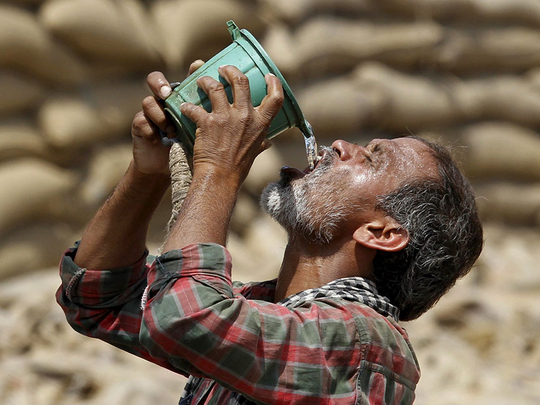
India’s water crisis is perennial in nature and ‘Latur’ in Maharashtra is a synonym for water scarcity in the country. India’s water crisis has been in the making for a long time but the last 30 years has seen this calamity reach epic proportions. Each succeeding year brings in its wake ever more challenging problems and Gulf News’ lead story “Which is greater: Indians’ thirst for cricket or Indians’ thirst” captures the current crisis eloquently. Equally catchy was PBS’s Newshour headline of April 13: “Can water ATM’s solve India’s water crisis”.
Political apathy, unsustainable growth, the burgeoning population increase, climate change, massive urbanisation, irrigation and crop pattern changes — in particular sugar cane production — are some of the reasons, but surely a nation that puts an orbiter around Mars, aspires to land a man on the Moon, wants to acquire a bullet train and develop a blue water navy should have found a solution.
One of the prescient voices on this crisis has been that of noted filmmaker Shekar Kapur, director of award winning Hollywood classic Elizabeth. His Sisyphus-like efforts to produce a movie called Paani (Water) for over 13 years is a reflection of the crisis itself. Kapur’s lament is that big Indian producers do not feel strongly about the subject; indeed the middle class, the rich and the political class are not engaged with this problem. For most of this class the water crisis is something to be debated in the TV studios in April and May each year and promptly forgotten thereafter. After all it does not impact their lives but recently Times Now, a TV station, that comes in for scathing comments on its cacophonic style of news presentation did a great job of capturing attention on a problem that would otherwise have been lost in the din of everyday news gathering.
However the horrifying statistics, the bare, unvarnished truths and facts on the ground should have shaken even a disinterested civil society out of its deep slumber. Much as it may be enamoured of glitzy malls, manicured lawns, roof top swimming pools and gated communities anchored around golf courses it is time for it to wake up.
So what indeed are these alarming groundwater realities?
The qualifier ‘water’ has been deliberately used to emphasise how critical this precious liquid trapped beneath the surface is and how intertwined it is with surface water and reservoirs like rivers and lakes. The key is actually a judicious mix of the use of surface water and ground water but it is here that the country is dangerously losing the plot.
Dependent on rainfall
Close to 100 million Indians live in areas of poor water quality. Over 54 per cent of India faces high to extremely high water stress. Next, 55 per cent of India’s total water supply depends on ground water but as borewells are dug for unbridled extraction of this valuable asset due to cropping pattern changes this public resource gets depleted. The water needed for one acre of sugarcane can irrigate 10-12 acres of food crops like cereals.
India depends precariously on seasonal rainfall, the South-West monsoon in particular. Over 70 per cent of agriculture is dependent on rainfall, irrigated land is but a minor player in India’s agro-business and critically even irrigation depends on ground water (over 60 per cent). Therefore water traps and reservoirs — dams, big and small, rivers and lakes — are just subsidiary feeders to irrigation schemes.
It is in this context that Maharashtra and its sugar cane industry looms large. This state is the second highest producer of sugar in the country, the state of Uttar Pradesh being the first, and its yields per acre are far higher than UP’s but it uses 2,028 litres of water to produce 1kg of sugar as opposed to 1,044 litres in UP, virtually double its water consumption. The sugar industry region in Maharashtra, Marathwada, digs as many as 10,000 borewells per month to feed this gargantuan thirst for water and plays havoc with the water table, depleting the ground water resources; the density of borewells here is so high that the landscape is like a sieve. But the worst is yet to come, research has shown that the effluents produced during the sugar manufacturing process gets absorbed by ground water contaminating it to dangerous levels. It needs to be also said that sugar industry receives a disproportionate amount of political patronage.
It would be naive to blame the sugar industry for all the ills but don’t forget the biggest name associated with sugar production in the country is that of Sharad Pawar, an erstwhile cabinet minister for agriculture; indeed some would anoint him as the father of the sugar industry.
Incidentally, he also happens to be intimately involved with cricket in India and the question — if Indians thirst for cricket is greater or lesser than their thirst — takes on an ominous turn. In the wake of the controversy regarding IPL matches and the strictures passed by the courts, he offered to use untreated sewage water to ensure IPL matches are not shifted out of Maharashtra.
Unsurprisingly Latur is very much a part of Marathwada; the epicentre for water scarcity. Pawar is also associated with Lavasa, the hill city project in Maharashtra that is a water guzzler.
Ravi Menon is a Dubai-based writer, working on a series of essays on India and on a public service initiative called India Talks.









